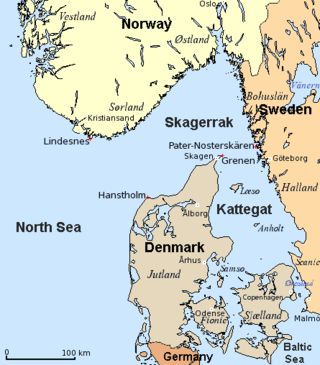
The Skagerrak is a strait running between the Jutland peninsula of Denmark, the east coast of Norway and the west coast of Sweden, connecting the North Sea and the Kattegat sea.
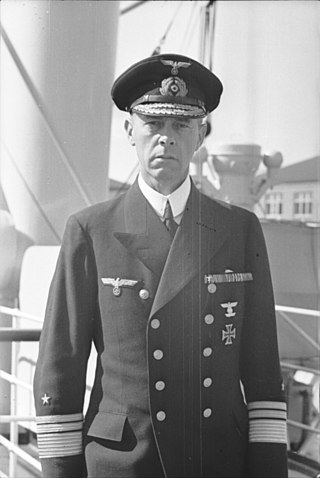
Operation Rheinübung was the last sortie into the Atlantic by the new German battleship Bismarck and heavy cruiser Prinz Eugen on 18–27 May 1941, during World War II. This operation aimed to block Allied shipping to the United Kingdom as the previously successful Operation Berlin had done. After Bismarck had sunk HMS Hood during battle of the Denmark Strait, it culminated with the sinking of Bismarck, while Prinz Eugen escaped to port in occupied France. From that point on, Germans would rely only on U-boats to wage the Battle of the Atlantic.

Sweden maintained its policy of neutrality during World War II. When the war began on 1 September 1939, the fate of Sweden was unclear. But by a combination of its geopolitical location in the Scandinavian Peninsula, realpolitik maneuvering during an unpredictable course of events, and a dedicated military build-up after 1942, Sweden kept its official neutrality status throughout the war. At the outbreak of hostilities, Sweden had held a neutral stance in international relations for more than a century, since the end of the Napoleonic Wars in 1814 and the invasion of Norway.

A blockade runner is a merchant vessel used for evading a naval blockade of a port or strait. It is usually light and fast, using stealth and speed rather than confronting the blockaders in order to break the blockade. Blockade runners usually transport cargo, for example bringing food or arms to a blockaded city. They have also carried mail in an attempt to communicate with the outside world.
Swedish iron ore was an important economic and military factor in the European theatre of World War II, as Sweden was the main contributor of iron ore to Nazi Germany. The average percentages by source of Nazi Germany’s iron ore procurement through 1933–43 by source were: Sweden: 43.0 Domestic production (Germany): 28.2 France: 12.9. Within the German military the Navy was most dependent on Swedish steel as an absolute necessity to the German war effort, according to their grand admiral. It has also been argued that the Swedish export helped prolong the war.

Admiral Hipper was the lead ship of the Admiral Hipper class of heavy cruisers which served with Nazi Germany's Kriegsmarine during World War II. The ship was laid down at the Blohm & Voss shipyard in Hamburg in July 1935 and launched February 1937; Admiral Hipper entered service shortly before the outbreak of war, in April 1939. The ship was named after Admiral Franz von Hipper, commander of the German battlecruiser squadron during the Battle of Jutland in 1916 and later commander-in-chief of the German High Seas Fleet. She was armed with a main battery of eight 20.3 cm (8 in) guns and, although nominally under the 10,000-long-ton (10,160 t) limit set by the Anglo-German Naval Agreement, actually displaced over 16,000 long tons (16,260 t).
Operation Wilfred was a British naval operation during the Second World War that involved the mining of the channel between Norway and its offshore islands to prevent the transport of Swedish iron ore through neutral Norwegian waters to be used to sustain the German war effort. The Allies assumed that Wilfred would provoke a German response in Norway and prepared a separate operation known as Plan R 4 to occupy Narvik and other important locations.

Operation Berlin was a raid conducted by the two German Scharnhorst-class battleships against Allied shipping in the North Atlantic between 22 January and 22 March 1941. It formed part of the Battle of the Atlantic during World War II. The Scharnhorst and Gneisenau sailed from Germany, operated across the North Atlantic, sank or captured 22 Allied merchant vessels, and finished their mission by docking in occupied France. The British military sought to locate and attack the German battleships, but failed to damage them.

HMS Escapade was an E-class destroyer built for the Royal Navy in the early 1930s. Although assigned to the Home Fleet upon completion in 1934, the ship was attached to the Mediterranean Fleet in 1935–1936 during the Abyssinia Crisis. During the Spanish Civil War of 1936–1939 she spent considerable time in Spanish waters, enforcing the arms blockade imposed by Britain and France on both sides of the conflict. Escapade was assigned to convoy escort and anti-submarine patrol duties in the Western Approaches when World War II began in September 1939, but transferred back to the Home Fleet at the end of the year.
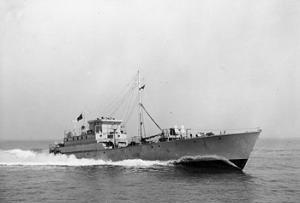
Gay Viking was a blockade runner of the British Merchant Navy. Originally under construction as a Motor Gun Boat, Gay Viking was one of eight vessels that were ordered by the Turkish Navy, but were requisitioned by the Royal Navy to serve with Coastal Forces during the Second World War. Originally intended to be HMMGB 506, the vessel was instead completed as a blockade runner for the Merchant Navy and named Gay Viking. She operated out of Hull on two separate operations to the Scandinavian countries. She was one of the more successful of her group, but was lost in a collision while returning from one of these operations. Reports indicate that she may have been salvaged after this and gone on to sail for a considerable number of years as a civilian vessel.

Operation Weserübung was the invasion of Denmark and Norway by Nazi Germany during the Second World War and the opening operation of the Norwegian Campaign.

Operation Postmaster was a British special operation conducted on the Spanish island of Fernando Po, now known as Bioko, off West Africa in the Gulf of Guinea, during the Second World War. The mission was carried out by the Small Scale Raiding Force (SSRF) and the Special Operations Executive (SOE) in January 1942. Their objective was to board the Italian and German ships in the harbour and sail them to Lagos. The SSRF under the command of Major Gus March-Phillipps left Britain in August 1941 and sailed the Brixham trawler, Maid of Honour, to the Spanish colony.

The action off Lerwick was a naval engagement on 17 October 1917 fought in the North Sea during the First World War. The German light, minelaying cruisers SMS Brummer and Bremse attacked a westbound convoy of twelve colliers and other merchant ships and their escorts, part of the regular Scandinavian convoy. The two escorting destroyers and nine neutral Scandinavian ships were sunk off Shetland, Scotland.

Z16 Friedrich Eckoldt was a Type 1934A-class destroyer built for Nazi Germany's Kriegsmarine in the late 1930s. It was named after Kapitänleutnant Friedrich Eckoldt (1887–1916), the commander of torpedo boat V 48, who was killed when his boat was sunk during the Battle of Jutland on 31 May 1916.
Sir Frederick George Binney, DSO was a noted Arctic explorer. During the Second World War, he led blockade running missions, including Operation Rubble, to procure supplies of Swedish ball bearings and other steel products for British aramament production, for which he was knighted and made a Royal Naval Volunteer Reserve commander.
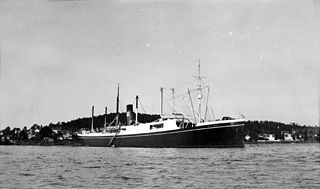
The kvarstad vessels were a number of Norwegian ships held in arrest in Gothenburg during World War II. The ships had been visiting Swedish ports when the German invasion of Norway took place in April 1940. They were eventually claimed by Nortraship, which represented the Norwegian exile government and the British Government, but also by the Germany-supported Quisling regime in Norway. The fate of the ships was disputed through a number of diplomatic notes and trials between the involved parties. The disputed vessels originally numbered 42 ships, with a total of 170,000 ton dw. Some of the ships returned early to occupied Norway, some after recommendation from the Administrative Council. In January 1941 the British Operation Rubble succeeded in bringing five of the ships to the Orkney Islands.
MV Storsten was a Norwegian tanker built in 1926, and sunk by German aircraft in the Skagerrak on 1 April 1942.

The Type 1934 destroyers, also known as the Z1 class or Leberecht Maass class after the lead ship, were a group of four destroyers built for the German Navy during the mid-1930s, shortly before the beginning of World War II. The ships were engaged in training for most of the period between their commissioning and the outbreak of war, although they did participate in the occupation of Memel in Lithuania, in early 1939. Z3 Max Schultz collided with and sank a German torpedo boat shortly before the war began on 1 September 1939. All four ships were named after German officers who had been killed in World War I.
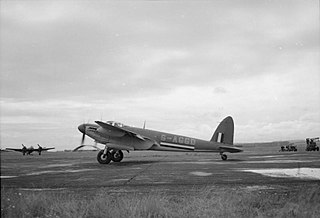
Ball-bearing Run was the nickname of the war-time Stockholmsruten flight between Stockholm and Leuchars, Scotland between 1939 and 1945. After 1942 the flight was run by the Royal Norwegian Air Force, but for political reasons operated as an ordinary BOAC Flight, the unarmed aircraft having civilian registration and the Norwegian military crew wearing BOAC uniforms and carrying British passports. The Stockholmsruten was set up by the Norwegian Government, exiled in UK with the aim of transporting Norwegians having escaped from Nazi-occupied Norway. Several types of aircraft were used, but the backbone of Stockholmsruten was the Lockheed Lodestar.

Operation Northern Mark was a sortie by a German flotilla of two battleships and a heavy cruiser against British merchant shipping between Norway and Shetland from 18 to 20 February 1940. The sortie was intended as a riposte to the Altmark incident, to create confusion to help German blockade-runners reach home and as a prelude to more ambitious operations in the Atlantic. The flotilla was spotted by the British early on, who held back a Norway-bound convoy.



















